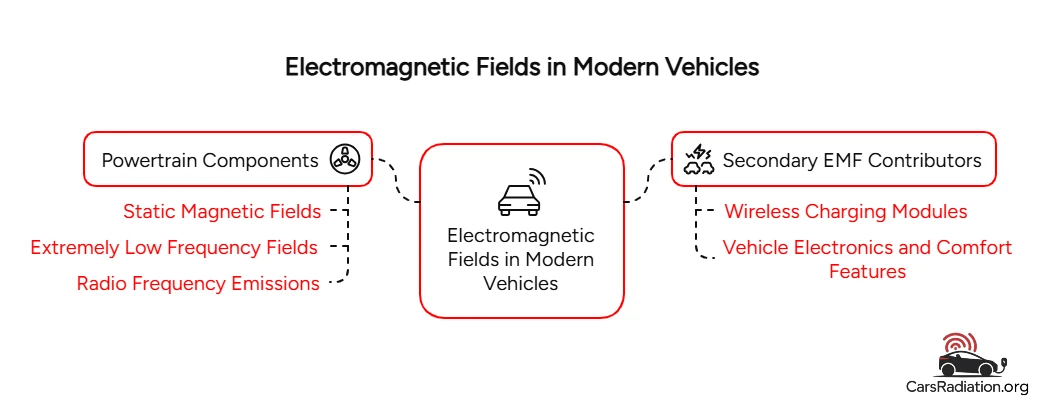Basics of Electromagnetic Radiation in Cars

The rapid advancement of vehicular technologies, particularly the integration of high-capacity batteries, complex electronics, and onboard communication systems, has led to the emergence of non-traditional risk vectors.
One such vector, frequently under-recognized yet increasingly relevant, is electromagnetic radiation generated within the vehicle environment. Unlike conventional automotive hazards such as particulate emissions or component fatigue, electromagnetic radiation is not perceptible through human senses, and thus is often overlooked in early-stage assessments of vehicular safety.
However, accumulating scientific evidence has demonstrated that electromagnetic emissions, even when operating within nominal or regulated thresholds, can pose a persistent biological risk, particularly under chronic exposure conditions.
This has prompted regulatory agencies, public health bodies, and vehicle manufacturers to re-evaluate design and operational frameworks for emerging vehicle platforms, especially in the context of electric and hybrid electric vehicles (EVs and HEVs).
Definition and Classification of Radiation
Radiation, in the context of vehicle safety, refers to the emission and propagation of energy through a medium or vacuum in the form of electromagnetic waves or particles.
For automotive applications, the primary concern lies within the electromagnetic spectrum, specifically, the non-ionizing region.
Non-Ionizing Radiation
Lower-frequency electromagnetic fields (EMFs), including radiofrequency (RF), microwave, and extremely low frequency (ELF) components. This form constitutes the dominant radiation profile observed within electric and hybrid vehicles.
Multiple studies have indicated that prolonged exposure to ELF magnetic fields (particularly in the tens to hundreds of hertz range, characteristic of automotive electric drive systems) may induce measurable biological responses. These include interference with neuro-electrical signaling, oxidative stress generation, and potential links to long-term health effects under sustained exposure scenarios.
Types of Radiation in Cars
 Electromagnetic fields (EMFs) within modern vehicles, especially those powered by electricity or hybrid systems, originate from multiple sources. These include both intentional emissions related to vehicle functionality and incidental fields generated as a byproduct of power distribution and component operation.
Electromagnetic fields (EMFs) within modern vehicles, especially those powered by electricity or hybrid systems, originate from multiple sources. These include both intentional emissions related to vehicle functionality and incidental fields generated as a byproduct of power distribution and component operation.
The EMF spectrum encountered in vehicles spans from static magnetic fields to high-frequency RF signals.
EMFs from Powertrain Components
Electric and hybrid propulsion systems utilize high-capacity battery packs, DC/AC inverters, and switching power electronics to energize and control the drive motor. Each of these subsystems introduces characteristic electromagnetic signatures into the cabin environment:
- Static Magnetic Fields (SMF): Produced by direct current (DC) circuits, including battery packs and DC bus lines. These fields are unidirectional and persist without oscillation.
- Extremely Low Frequency (ELF) Fields: Resulting from alternating current (AC) operation of inverters, chargers, and auxiliary motor systems. These fields typically operate within the 20–300 Hz range, with dominant spectral components around 50–100 Hz. These fields are the main health concern in vehicles. They belong to the “non-thermal” (the more dangerous) type of effect on the body and are categorized as “possibly cancerogenic” by the WHO due to findings related to Childhood Leukemia risks.
- Radio Frequency (RF) Emissions: Emitted from embedded communication modules such as Bluetooth, Wi-Fi, LTE modems, and keyless entry systems. These operate in the MHz–GHz range and are subject to radiated emissions standards.
Magnetic field strengths measured in cabin areas, particularly adjacent to footwells, seats, and floor-mounted battery enclosures, have been reported to reach values up to 30 µT. While these levels are often compliant with guidelines for acute, one-time, short duration exposure (e.g., ICNIRP or IEEE C95.1), they significantly exceed levels viewed as safe for cumulative (chronic) exposure profile (which is around 0.3-0.4 µT).
Secondary EMF Contributors
Beyond propulsion-related sources, additional subsystems contribute to the total EMF environment within the vehicle:
- Wireless Charging Modules: Systems designed for inductive charging (vehicle-to-grid or device charging) generate time-varying magnetic fields during power transfer. Field strength and frequency content are a function of the coil design, coupling efficiency, and operational current.
- Vehicle Electronics and Comfort Features: Infotainment systems, navigation modules, heated seating elements, and driver-assist sensors operate across various frequencies and radiate both intentional and incidental EMFs. Embedded antennas and integrated transceivers further increase the local field intensity.
It is important to distinguish between natural geomagnetic fields, which are static and non-inductive, and vehicle-induced electromagnetic radiation, which is synthetic, design-dependent, and characterized by alternating fields capable of inducing currents in biological tissues.

Preventive Measures
The mitigation of electromagnetic field (EMF) exposure in passenger vehicles requires a multidisciplinary method including engineering design, user behavior, and regulatory compliance. This section outlines the current methodologies employed across these domains and evaluates their respective effectiveness.
Design and Technological Mitigation Techniques
Modern vehicle architectures increasingly incorporate EMF-reducing design strategies. The principal categories include:
Electromagnetic Shielding
High-voltage conductors and power electronics, such as inverters and onboard chargers, are encased in conductive enclosures (typically metallic) designed to suppress leakage of low-frequency magnetic fields. This method is widely adopted across vehicle platforms and matches with general principles of Faraday shielding. Although conventional shielding is not effective in shielding magnetic fields due to the extremely low frequency of the electromagnetic fields. To effectively shield such fields, special, high permeability materials are needed. In addition, magnetic fields’ shielding effectiveness is very poor if the source of the field is not entirely covered by the shield- which is largely the case in vehicles.
Component Placement Optimization
Vehicle layouts that position high-current components away from occupants, for example undercarriage battery modules or rear-mounted converters, contribute to field attenuation at typical seating locations. While spatial limitations may restrict such optimizations, their implementation can lead to significant reductions in occupant exposure levels.
Active Field Cancellation
Advanced techniques, such as those developed by SafeFields Technologies, employ phase-inverted magnetic field sources to actively suppress the net EMF within the cabin. These systems function on the principle of destructive interference, wherein secondary fields are generated to negate the primary emissions at targeted zones.
Controlled testing of SafeFields’ solution has shown a quantifiable reduction in magnetic field intensity measured at occupant positions, validating the efficacy of active cancellation as a viable engineering control.
Behavioral Exposure Management
 While engineering controls remain the primary mechanism for EMF mitigation, occupant behavior can influence exposure profiles in measurable ways. Recommended practices include:
While engineering controls remain the primary mechanism for EMF mitigation, occupant behavior can influence exposure profiles in measurable ways. Recommended practices include:
Seat Positioning Awareness
Occupants should avoid prolonged sitting directly above high-emission components. For example, rear seats located above battery packs may exhibit increased field levels.
Charging Precautions
Particularly during DC fast-charging events, transient magnetic field intensities may exceed in-cabin operational levels. Avoiding proximity to the vehicle during such sessions can reduce unnecessary exposure.
Population-Specific Considerations
Vulnerable groups such as pregnant women and children are more susceptible to biological effects from low-frequency fields. Shortening trip durations or selecting lower-EMF vehicle configurations may be advisable in such cases.
Regulatory Framework and Industry Benchmarking
At present, regulatory oversight of vehicle EMF levels is defined by voluntary and region-specific guidelines rather than globally harmonized mandates. The primary frameworks include:
ICNIRP and WHO Recommendations
The International Commission on Non-Ionizing Radiation Protection (ICNIRP) and the World Health Organization (WHO) outline exposure thresholds for extremely low frequency (ELF) and radiofrequency (RF) fields. These guidelines form the basis for safety assessments performed by OEMs and independent labs.
European Commission Initiatives
Recent evaluations from the European Commission stress the necessity of standardized field measurement protocols and design-stage compliance assessments in electric and hybrid vehicles. These include application of IEC 62764 and related standards for consistency.
New Car Assessment (NCAP) Programs
Some vehicle safety programs have already initiated EMF-specific assessment procedures. Notably, China’s New Car Assessment Program (C-NCAP) has implemented a grading methodology that evaluates electromagnetic radiation levels during vehicle operation. Vehicles are classified based on measured field strengths within the cabin. This grading system introduces a quantitative benchmark for in-vehicle EMF exposure, allowing comparative analysis across models.
This program is anticipated to expand internationally. Other NCAP frameworks are expected to adopt similar criteria and establish a unified reference for EMF safety performance. The result will be increased transparency and standardized consumer information regarding magnetic field exposure risks in electrified transport platforms.

